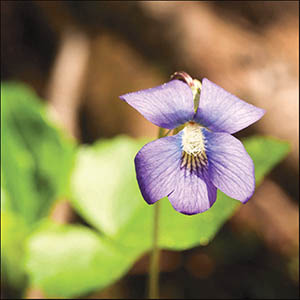The Violet. This powerhouse of a flower tastes good, has medicinal uses, and it also feeds bees, butterflies, birds, and wildlife.
By Juneann Green
Throughout the United States, these showy springtime flowers can be seen growing along roadsides, in shady woodland areas, in fields, and our own backyards.
The dark-green, heart-shaped, shallow-toothed leaves of violets grow in thick clumps, dotted in late spring by fragrant little white and blue/violet flowers. She has five petals, in various hues of blue, with a symmetrical, butterfly shape. In the lower middle of the flower, is her nectar spur that attracts early-season pollinators.
Botanically speaking, almost all violets are perennials belonging to the genus Viola and come in over 100 different varieties. This hardy wildflower never grows more than a foot tall and grows well in full sun or partial shade. She grows low to the ground in a rosette and will come back yearly in the same spot and eventually spread throughout the area.
The dainty, wild violet has a lot more use than in a flower arrangement or as something to enjoy on a hiking trail. This herbaceous perennial is edible and has been cultivated for over two thousand years for its fragrance and medicinal uses.
The lure of this edible flower is easy to explain. It is their ability to light up the garden, or maybe it’s how they decorate a plate. Both the leaves and flowers are edible and packed with vitamin C and vitamin A. Her tiny purple flowers can be used as a garnish on a plate, added to a salad or soup, candied or crystallized to decorate cakes, or used in honeys, teas, vinegars, or syrups. The taste of the violet petal is often described as sweet and floral.
So my fellow Master Gardener, think twice before weeding out these wild violets! This powerhouse of a flower not only tastes good, and has medicinal uses, it also feeds bees, butterflies, birds, and other wildlife. They make lovely ground covering in areas too shady for grass to survive. This is truly a well-rounded, versatile plant that is always welcome in my garden.
Juneann Green, a Garland County Master Gardener, volunteers with GC Master Gardeners of the UofA Div. of Agriculture, Cooperative Ext. Service. Master Gardeners pool skills and resources to improve home horticulture, stimulate interest in plants and gardening, and encourage beautification. For more info, call 501-623-6841 or email abates@uaex.edu.









